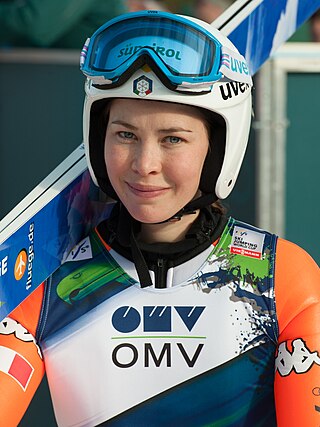This article needs additional citations for verification .(February 2023) |
| 1990 Women's combined World Cup | |
| Previous: 1989 | Next: 1991 |
Women's combined World Cup 1989/1990
This article needs additional citations for verification .(February 2023) |
| 1990 Women's combined World Cup | |
| Previous: 1989 | Next: 1991 |
Women's combined World Cup 1989/1990
| Round | Race No | Discipline | Place | Country | Date | Winner | Second | Third |
|---|---|---|---|---|---|---|---|---|
| 1 | 9 | Downhill slalom | Steamboat Springs | December 9, 1989 December 10, 1989 | | | | |
| 2 | 17 | Downhill slalom | Haus im Ennstal | January 13, 1990 January 14, 1990 | | | |
In women's combined World Cup 1989/90 both results count. [2]
| Place | Name | Country | Total Points | 9 | 17 |
|---|---|---|---|---|---|
| 1 | Anita Wachter | 35 | 15 | 20 | |
| 2 | Michaela Gerg | 32 | 20 | 12 | |
| 3 | Brigitte Oertli | 25 | 25 | - | |
| Petra Kronberger | 25 | - | 25 | ||
| 5 | Chantal Bournissen | 23 | 12 | 11 | |
| 6 | Ingrid Stöckl | 21 | 6 | 15 | |
| 7 | Maria Walliser | 17 | 8 | 9 | |
| 8 | Heidi Zurbriggen | 14 | 4 | 10 | |
| Anja Haas | 14 | 7 | 7 | ||
| 10 | Kristi Terzian | 11 | 11 | - | |
| 11 | Stefanie Schuster | 10 | 10 | - | |
| 12 | Sylvia Eder | 9 | 9 | - | |
| 13 | Michelle McKendry | 8 | - | 8 | |
| 14 | Heidi Zeller | 7 | 2 | 5 | |
| 15 | Karin Dedler | 6 | - | 6 | |
| 16 | Hilary Lindh | 5 | 5 | - | |
| 17 | Gaby May | 4 | - | 4 | |
| 18 | Miriam Vogt | 3 | 3 | - | |
| Marianne Aam | 3 | - | 3 | ||
| 20 | Kristin Krone | 2 | - | 2 | |
| 21 | Katja Seizinger | 1 | 1 | - | |
| Svetlana Gladysheva | 1 | - | 1 |
| Alpine skiing World Cup | |
| Women | |
Overall | Downhill | Super-G | Giant slalom | Slalom | Combined | |
| 1990 |

Ski jumping is a winter sport in which competitors aim to achieve the farthest jump after sliding down on their skis from a specially designed curved ramp. Along with jump length, competitor's aerial style and other factors also affect the final score. Ski jumping was first contested in Norway in the late 19th century, and later spread through Europe and North America in the early 20th century. Along with cross-country skiing, it constitutes the traditional group of Nordic skiing disciplines.

The International Ski and Snowboard Federation, also known as FIS, is the highest international governing body for skiing and snowboarding. It was previously known as the International Ski Federation until 26 May 2022 when the name was changed to include snowboard.

The FIS Alpine Ski World Cup is the top international circuit of alpine skiing competitions, launched in 1966 by a group of ski racing friends and experts which included French journalist Serge Lang and the alpine ski team directors from France and the USA. It was soon backed by International Ski Federation president Marc Hodler during the FIS Alpine World Ski Championships 1966 at Portillo, Chile, and became an official FIS event in the spring of 1967 after the FIS Congress at Beirut, Lebanon.

Downhill is a form of alpine skiing competition. Whereas the other alpine skiing events emphasize turning and technique, downhill emphasizes "the six components of technique, courage, speed, risk, physical condition and judgement", according to the FIS "International Ski Competition Rules (ICR)". Speeds of up to 130 km/h (81 mph) are common in international competition. Athletes must have an aerodynamically efficient tuck position to minimize drag and increase speed.

The FIS Nordic World Ski Championships is a biennial Nordic skiing event organized by the International Ski Federation (FIS). The World Championships was started in 1925 for men and opened for women's participation in 1954. World Championship events include Nordic skiing's three disciplines: cross-country skiing, ski jumping, and Nordic combined. From 1924 to 1939, the World Championships were held every year, including the Winter Olympics. After World War II, the World Championships were held every four years from 1950 to 1982. Since 1985, the World Championships have been held in odd-numbered years.
The 24th World Cup season began in August 1989 in Australia and Argentina, resumed in November 1989 in the United States and concluded in March 1990 in Sweden. During this season, the Soviet Union's empire collapsed, leading to the reunification of East and West Germany, the dissolution of Yugoslavia and Czechoslovakia, and many other changes in Eastern Europe, which would have a significant effect on future World Cup seasons.
The 23rd World Cup season began in November 1988 in Austria and concluded in March 1989 in Japan. The overall champions were Marc Girardelli of Luxembourg and Vreni Schneider of Switzerland. Schneider established the record for victories in a World Cup season, winning a total of 14 races, surpassing the record of 13 established in 1978-79 by the great Swedish skier and three-time overall World Cup champion Ingemar Stenmark.
Women's downhill World Cup 1990/1991
Women's Super-G World Cup 1990/1991
Women's giant slalom World Cup 1990/1991

The 44th World Cup season began on 24 October 2009, in Sölden, Austria, and concluded on 14 March 2010, at the World Cup finals in Garmisch, Germany.

Elena Runggaldier is an Italian former ski jumper and Nordic combined skier representing G.S. Fiamme Gialle.

The 46th World Cup season began on 22 October 2011, in Sölden, Austria, and concluded on 18 March 2012, at the World Cup finals in Schladming, Austria.

The 47th World Cup season began on 27 October 2012, in Sölden, Austria, and concluded on 17 March 2013, at the World Cup finals in Lenzerheide, Switzerland. The overall titles were won by Marcel Hirscher of Austria and Tina Maze of Slovenia.

Ilka Štuhec is a Slovenian World Cup alpine ski racer, focusing on the speed events of downhill and super-G. She was a three-time junior world champion in three different disciplines, and was the world champion in downhill in 2017 and 2019.

The International Ski Federation (FIS) Alpine Ski World Cup, the premier circuit for alpine skiing competition, began in January 1967, and the 2019–20 season marked the 54th consecutive year for the FIS World Cup. As it had every year since 2006, the season began in Sölden, Austria in October. The season was supposed to end with the World Cup finals in March, which were to be held in Cortina d'Ampezzo, Italy for the first time since they began in 1993, but the finals were cancelled due to the COVID-19 outbreak in Italy.
The FIS Ski Tour 2020 was a cross-country skiing competition held as a part of the 2019–20 FIS Cross-Country World Cup. This stage event took place in Sweden and Norway, on ski resorts well-known from other skiing disciplines like alpine skiing or biathlon. The tour began in Östersund, Sweden on 15 February 2020 and concluded with the pursuit stage in Trondheim, Norway, on 23 February 2020. It consisted six stages, which were awarded with reduced number of World Cup points. For the overall standings they received three times the World Cup points compared to a regular individual World Cup event.
The 2022/23 FIS Nordic Combined World Cup, organized by the International Ski Federation was the 40th Nordic Combined World Cup season for men, and the 3rd season for women. The men's competition started in Ruka, Finland and concluded in Lahti, Finland. The women's competition started in Lillehammer, Norway and concluded in Oslo, Norway.
The 2022/23 FIS Cross-Country World Cup, organized by the International Ski Federation was the 42nd World Cup in cross-country skiing for men and women. The season started on 25 November 2022 in Ruka, Finland and concluded on 26 March 2023 in Lahti, Finland.

The International Ski Federation (FIS) Alpine Ski World Cup was the premier circuit for alpine skiing competition. The inaugural season launched in January 1967, and the 2022–23 season marks the 57th consecutive year for the FIS World Cup.